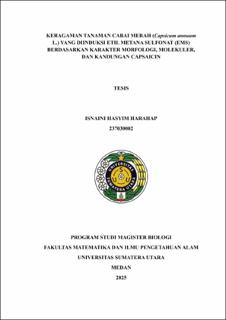Keragaman Tanaman Cabai Merah (Capsicum Annuum L.) yang Diinduksi Etil Metana Sulfonat (EMS) Berdasarkan Karakter Morfologi, Molekuler, dan Kandungan Capsaicin
Diversity of Red Chili Pepper (Capsicum annuum L.) Induced by Ethyl Methanesulfonate (EMS) Based on Morphological, Molecular, and Capsaicin Content

Date
2025Author
Harahap, Isnaini Hasyim
Advisor(s)
Elimasni
Hannum, Saleha
Metadata
Show full item recordAbstract
The red chili peppers (Capsicum annuum L.) are horticultural plants containing capsaicin as their primary bioactive compound. The low adaptability of red chili peppers is feared to cause limited genetic diversity. Efforts to increase genetic diversity can be done through mutation induction using ethyl methanesulfonate (EMS). This study aims to analyze the morphological diversity of red chili plants after mutation induction with EMS, analyze the morphological character diversity of red chili plants after mutation induction with EMS using simple sequence repeat (SSR) markers, and analyze the effect of various EMS concentrations on increasing capsaicin content in red chili pepper. The experimental design used a non-factorial completely randomized design (CRD) with eight EMS concentrations: 0.00% (M0); 0.10% (M1); 0.20% (M2); 0.30% (M3); 0.40% (M4); 0.50% (M5); 0.60% (M6); and 0.70% (M7). The research stages included preparing EMS stock solutions, EMS induction, sowing, planting, phenotypic analysis, capsaicin content analysis using a spectrophotometer, and molecular analysis using three SSR primers: SK00154, CAMS075, and CAMS236. The results showed that EMS effected on the morphological variation of red chili peppers. M1 exhibited superior performance in plant height, stem diameter, number of leaves, and number of fruits. M2 was best in leaf length. M4 showed superiority in leaf width, fruit weight, and number of seeds per fruit. M5 had the highest capsaicin content (7.162 mg/g). Primers SK00154 and CAMS075 were effective in detecting polymorphism (PIC > 0.5). Phylogenetic analysis showed that M2 had the greatest genetic distance from M0 (control). These findings indicate that mutation induction with the EMS can enhance phenotypic and molecular diversity and influence the capsaicin biosynthetic pathway.
Collections
- Master Theses [261]
